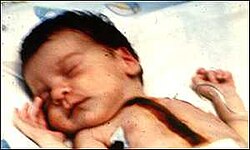Leonard L. Bailey
Stephanie Fae Beauclair (October 14, 1984 – November 15, 1984), better known as Baby Fae, was an American infant born in 1984 with hypoplastic left heart syndrome. She became the first infant subject of a xenotransplant procedure and first successful infant heart transplant, receiving the heart of a baboon. Though she died within a month of the procedure, she lived weeks longer than any previous recipient of a non-human heart.
The procedure, performed by Leonard L. Bailey at Loma Linda University Medical Center, was successful, but Fae died 21 days later of heart failure due to rejection of the transplant. The rejection is thought to have been caused largely by a humoral response against the graft, due to Fae's type O blood creating antibodies against the type AB xenograft. The blood type incompatibility was seen as unavoidable: fewer than 1% of baboons are type O, and Loma Linda only had seven young female baboons—all of which were type AB—available as potential donors.
It was hoped that the transplant could be replaced by an allograft at a later date, before Fae's body began generating isohaemagglutinins, but a suitable donor could not be found in time. Prior to the procedure, no infant heart transplant—even with human hearts—had been successfully performed due to a lack of infant human hearts. To address this issue, Bailey had become a pioneer in the research of cross-species heart transplants, which had included "more than 150 transplants in sheep, goats, and baboons".
A baboon heart was used as there was no time for a suitable human heart to be found. Multiple surgeons had previously experimented with baboon heart implants, leading some to speculate even that baboons could be farmed in the future for such purposes. When asked why he had picked a baboon over a primate more closely related to humans in evolution, Bailey replied, "I don't believe in evolution." Though she died within a month, Baby Fae, at the time of her death, had lived two weeks longer than any previous recipient of a non-human heart.
...
Wikipedia

